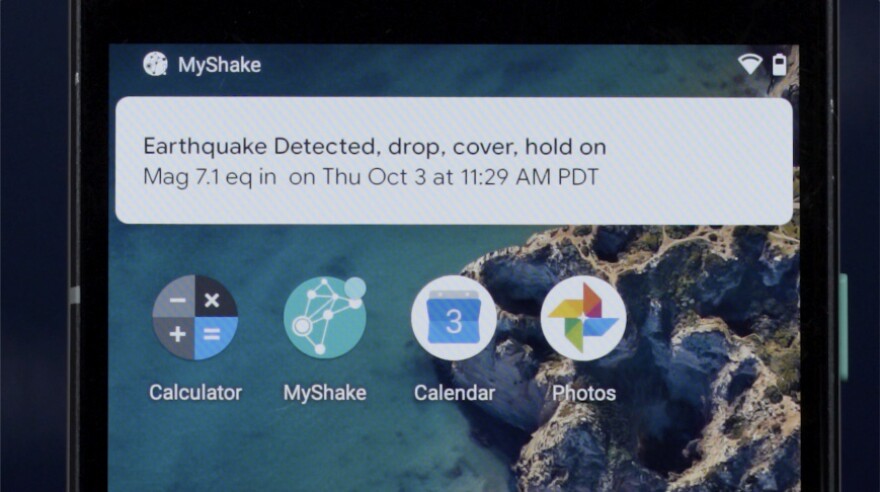Truth matters. Community matters. Your support makes both possible. LAist is one of the few places where news remains independent and free from political and corporate influence. Stand up for truth and for LAist. Make your year-end tax-deductible gift now.
California Finally Has An App That Can Tell You When The Earthquakes Are Coming

Starting today, no matter where you are in the state of California, you're now eligible for an early warning when an earthquake is about to hit your area.
State officials announced - on the 30th anniversary of the Loma Prieta quake - that a statewide earthquake early warning system is finally available to the general public.
HOW IT WORKS & HOW TO GET NOTIFIED
For years, the U.S. Geological Survey, Caltech and other institutions have been working together to build an earthquake early warning network throughout the state.
When a fault starts to slip, sensors placed nearby can record the waves of energy traveling through the earth, flag it for computers to estimate the size and intensity of the earthquake, and alert people before shaking starts.
This is all possible because electronic communications can travel faster than the waves.
People can be alerted via two different systems.
The first system is an app you can download called MyShake, which is available for both iOS and Android phones. If you don't have a smartphone or don't want to install the app, earthquake warnings will also be issued through a second system: the Wireless Emergency Alert System. That's the same system that pushes out AMBER Alerts.
The apps are expected to deliver the alerts more quickly than the WEA system, according to Brian Ferguson, Deputy Director Crisis Communications and Media Relations with the Governor's Office of Emergency Services.
WHY A FEW SECONDS MATTER
Any heads up, even seconds, can be enough time to slow down trains, open fire house doors, stop surgery or simply allow people to drop, cover and hold on.
In L.A., we can expect to get alerts that to arrive seconds, if not tens of seconds, ahead of a San Andreas quake slamming into us.
The closer you are to the epicenter of an earthquake, the less of a heads up you'll get, making the system less effective for the network of faults sitting right beneath the L.A. basin.
Systems like these are used in Japan and Mexico and have saved lives.
THE CONTEXT
Last January, L.A. released its own ShakeAlertLA app based on the same network that MyShake is using. However, it only works within L.A. County.
There have been hiccups. When the 7.1 magnitude Ridgecrest earthquake hit in July, some Angelenos were angry that they weren't alerted to the incoming shaking. The system had worked - picking up the waves before they reached L.A. - but they weren't big enough to trigger a warning from the app. In response to the frustration, officials quickly adjusted the notification system to make it more sensitive.
The MyShake app designers have set the threshold fairly low, notifying users of any quake larger than a magnitude 4.5.
ShakeAlertLA is still running and will continue to be developed, according to Mayor Eric Garcetti. He said he'd be using both apps, as the L.A. app has information that's specific to Angelenos, including the location of shelters following a quake.
"It's not just about the warning, it's about preparing ahead of time and recovering afterwards. And we want this to be the one stop shop where people can go and know that," he said.
In terms of tech, the MyShake app takes things a step further. It uses smartphone accelerometers to crowdsource shaking information.
As of 12:30 PM on Thursday, 438,000 phones were registered with MyShake, according to the app.
WHAT'S NEXT
"Perfect ... is not on the agenda," said California Governor Gavin Newsom during a press conference. There will likely be false alarms and missed earthquakes, though the system will continue to be developed.
"We recognize this is a work in progress that will have to iterate over the next few years," he said.
"You may receive alerts before, during or after the shaking," said Richard Allen, Director of the UC Berkeley Seismo Lab. "We still consider this to be a prototype system."
In the coming weeks there will be further announcements about how the system could be integrated into broader infrastructure. For instance, that could mean elevators and trains automatically coming to a stop when an alert is issued
Mayor Garcetti also hopes to integrate the alert system more fully into L.A.'s infrastructure.
For now, the MyShake app is only available in English.
LEARN MORE
- LA Now Has An Earthquake Alert App To Warn Us Before The Big One Hits
- Hey ShakeAlertLA: Where's The Earthquake Alert App For The Rest Of SoCal?
- How you can prepare for the Big One
WHY YOU SHOULD TRUST OUR REPORTING
I'm the host of KPCC/LAist's podcast The Big One: Your Survival Guide, a series that dug into what could happen if we were hit by a major San Andreas quake. As LAist's science reporter, I regularly report on earthquakes, and I source from (and fact-check with!) leading geophysicists and government officials.
YOUR QUESTIONS OR IDEAS








